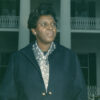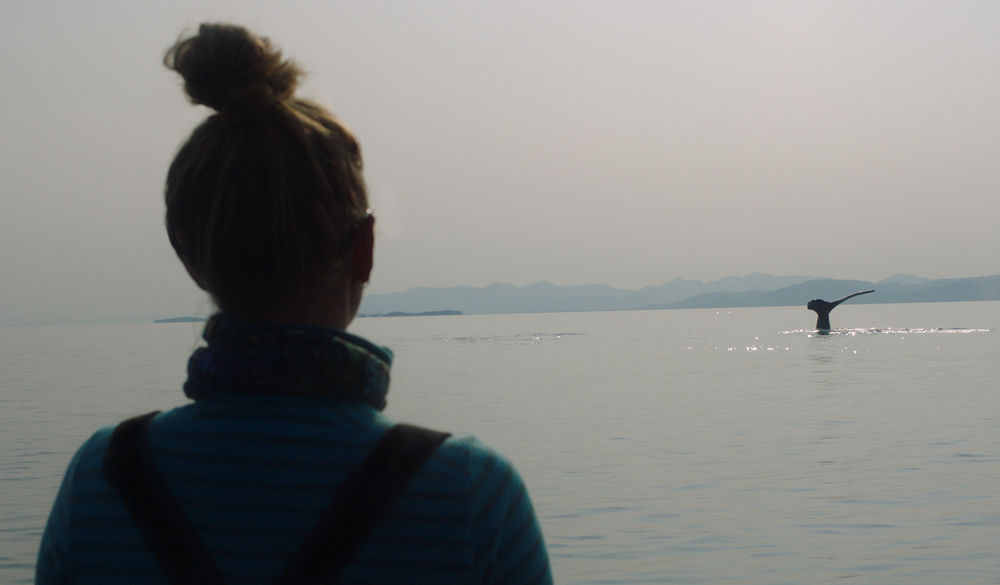“This is a much safer place to be a human,” Dr. Michelle Fournet confides in a friend, sitting out in the middle of Hobart Bay off the banks of Alaska, hoping to hear the call of a whale in “Fathom.” She’s given herself a month to survey various calls in the hopes of deciphering a pattern that could unlock their language, already distinguishing such unique sounds as the droplet call, the growl call, the teepee call and the whup, and while she’s slightly stressed that she won’t collect as many as she’d like before her study is set to end, there is a tranquility on the open water that she’s already feeling as if she’ll miss when she returns back to civilization and the grind of modern life.
In a film that’s essentially about whale communication, it is rather remarkable that some of the greatest epiphanies in Drew Xanthopoulos’ magnificent second feature has to do with humans listening to themselves. Along with Dr. Ellen Garland, who has built a career studying the songs of humpback whales to see how far they travel both across distance and time out of the University of St. Andrews in Scotland, going with their gut, Dr. Fournet is shown on the precipice of a breakthrough when it comes to understanding our fellow species in beginning to comprehend their primal language that serves as a building block for all that followed, though to get there has meant dedicating her life to a lonely pursuit when besides having a level of interest that few others do, there’s only room for so many on the boat she ships out on. Somehow Xanthopoulos was able to squeeze in, and for as many breathtaking shots of the ocean that the director is able to capture as Dr. Garland and Dr. Fournet carry on their studies, what’s most incredible is the insight he gains into how communication is a means of personal expression, observing the scientists able to trace distinctive calls back to specific whales and learning that their pursuit of that knowledge is driven by how they want to interact with the world on their own terms.
With producer Megan Gilbride, whose collaborations with Keith Maitland have yielded deeply humane films about the collective response to unthinkable events in “Tower” and “Dear Mr. Brody,” Xanthopoulos impressively builds “Fathom” around the desire to connect, whether that’s to other humans or to the natural world and the duo find exquisite ways to rouse all the senses even when the film is about chasing sound. As the film is given the spotlight at the Camden Film Festival following its premiere on AppleTV+ earlier this year, Gilbride and Xanthopoulos shared how they themselves connected to make the film, telling a story of epic scope when Xanthopoulos by necessity had only himself for a crew for the most part and translating the experience he had on the water into one accessible for all audiences.
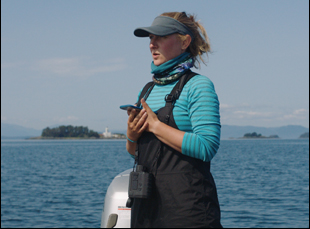
Drew Xanthopoulos: I’ve been dreaming about working with Megan for years and never thought that I was ever in her league, so I was always afraid to approach her to work on anything.
Megan Gilbride: It’s funny to hear because I feel like what happened was Drew called me and he told me about this movie and I was like, “That sounds good. We should do that.”
Drew Xanthopoulos: It was very fortunate. When it became clear what kind of a film this was going to be both in terms of the scientists involved and the subject matter, Megan was the only name that I had in mind for someone who could produce it.
Were Ellen and Michelle in mind as subjects from the start?
Drew Xanthopoulos: It was a total journey of discovery and first and foremost, we were looking for incredible scientists who were doing really good work, asking questions that were profound and also having to go out to sea for long periods of time. That whittled it down to not very many scientists [because it’s] very hard to get funding to go out to sea. And when we realized that this was also going to be the story of what it is to be a female researcher, it was very clear what we were doing was even more important, so Ellen and Michelle’s work is so complimentary. One is [looking into] a single sound and the effects of how that has on the relationship of whales across lifetimes and the other is looking at how far does their culture reach among themselves over across thousands of miles and ocean basins, so the macro and the micro there felt like really good complimentary stories.
Megan Gilbride: Michelle and Ellen are not just complimentary scientists, they’re complimentary personalities and their approach to their work is so thoughtful. They’re both very humble about how groundbreaking they are, and Drew had Michelle on board before I came on. Drew’s such a stunning shooter that watching the footage that he shot of her, and his point of view on the ocean was just so astounding. He had such a specific vision for what he wanted the ocean to look like in this film that was just beautiful and otherworldly that I’d never seen before that totally lined up with all the other themes we want it to talk about in the film, so watching Michelle and watching the ocean footage was just immediately intoxicating and then getting to have Ellen on board who is doing such profound work and [having] her saying yes [made this such] a wonderful process.
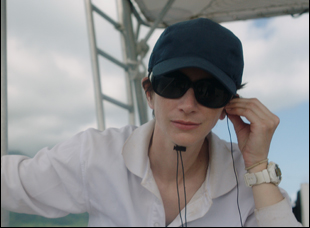
Megan Gilbride: The easy part of it was that Drew is a solo person who goes to shoot, so we’re only sending one person off into the void. It’s one person and a lot of stuff. I booked a lot of sea planes, which was new and fun for me and we sent him with some solar batteries, which is also a new thing. Thankfully, Michelle knew how to rewire them because they took a bath in the field and she was quickly able to get them back up and running, so thank God all of our scientists are also like backdoor electricians who could basically jerry-rig anything. That was the fun part of it.
Drew and I worked really closely on a lot of very detailed packing and traveling [plans], making sure we could get everything where it needed to be, but a lot of it was still done in the post-production process, working with Michelle and Ellen with their journals and their voiceover, so it was a good, healthy balance of minimally trying to get in front of disasters and then also trying to put baking soda on any fires that came up and maximal getting to enjoy time with the story and the footage.
Drew, when you’re on these boats that you don’t want to put much weight on besides wanting to be unobtrusive, was it difficult to get the equipment onboard that you needed to have to capture these remarkable scenes?
Drew Xanthopoulos: First, I had to figure out if I was going to get seasick or not on boats. The first one I ever went out on, I did get horribly seasick and I had to lay down on the lower deck for a few hours and I just fell asleep. I remember I woke up and I was so hungry, all I wanted to eat were rice crackers. Then I ate like two boxes of rice crackers, and I never got seasick on a single boat ever again. It was really bizarre. But the boats are really tight and in some ways having another person on there wouldn’t have even been possible or sound recorders or Megan.
Honestly, the hardest part on Michelle’s boat, for example, was just being really quiet. We’re all wearing rubber pants, sitting on an inflatable rubber boat and they’re in the quietest place in the world trying to listen for whales breathing to know where they are. Any little adjustment on your body will make like the loudest rubber on rubber sound, so it was really hard for me because if I wanted to reposition a little bit, it would make a noise every time, so I had to be really still in an unusual way and make sure I didn’t drop the camera in the water because that would have been the end of the film altogether. It was a really unique limitation that we’re in this incredibly wide open space, but we’re in a 16-foot inflatable boat where I can’t move three inches without ruining what they’re doing, so it was really claustrophobic, but also really wide open at the same time.
Megan Gilbride: That placidity is something we talked a lot about because we really wanted to recreate that experience of being there for the audience, so thinking about the quietest moments in “Jaws” where the sound of a canvas shoe slipping on the deck, that’s exactly what we were trying to recreate. We really wanted that unnerving feeling of expectation and anticipation of the quietness on the water and then a little bit of rubber on rubber to really kind of get you into that unnerving space and then that gorgeousness of a breath and trying to figure out where it came from. Recreating that in the edit and making sure that was a key part of the the sound design was so fun.
Michelle has a great line in the film about how it’s like a game of acoustic hide and seek with the whales. Was sound design a pretty interesting part of the process on this?
Drew Xanthopoulous: In some ways, it was the last thing we got to do in the edit, which was really frustrating because you’re constructing picture and you know that there’s going to be this lifeblood brought to the film with the sound design that isn’t quite there yet. Megan and I were both in the mix and it was just like one of the most incredible experiences to hear some of the best recordings of whales in human history that these two scientists have given us, then to really take poetic license and try to immerse an audience in these sounds. At one point, we gave a rough sound cut of a scene for the animator to work with and he came back to us and he said, “Listen, I really don’t want to tell you guys how to do the sound, but there’s just this one sound effect you guys put in there. It just doesn’t sound real.” And we’re like, “Sound effect?” And he points at the sound and it’s a real whale sound that sounds like a light saber. I’m a cinematographer and I’m telling you the sound is the best part of this film. [laughs]
Megan Gilbride: Not just that, but we’re talking about the quiet peace in Alaska, recreating Drew’s experience and a favorite thing for both of us just to see Ellen and Michelle both get immersed in their listening. That’s such a solitary experience for them, especially when Ellen’s on the boat and she’s listening for the song, that’s not a thing that Drew can hear, right? He’s there observing her observing the whales, so it’s really amazing to get to add that layer for the audience when Ellen finds the song to put the audience in that space of what only Ellen is gathering.
Drew Xanthopoulos: We’re also very much trying to capture what the scientists have so internalized about the sounds. Like Michelle will unconsciously just start tracing the sounds in the air as she’s listening to them. That’s how much she’s internalized it, so it’s trying to capture that in the film as well, where even though we’re not out at sea and we’re not even talking about whales, there’s an anecdote Michelle has about her stepfather teaching her the piano and how that plays into how she listens to things.
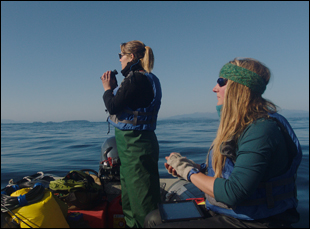
Drew Xanthopoulos: That was such a fun and difficult sequence to bring to life. We talked it that really early on didn’t we, Megan?
Megan Gilbride: It’s funny because when I think about moments of Drew and I talking through the story, that was one of those moments of trying to get the audience into the perceptive experience of an intelligent being that doesn’t perceive the world with light, but with with sound, [thinking] what would that be like? And even now, my hair stands on end thinking about us talking about that real mind bender, thinking about the world from an auditory key perception as opposed to from a visual key perception.
Drew Xanthopoulos: And that was super important to really push an audience into this because it should break your brain a little bit watching that sequence. You’re intuiting what’s happening and then you’re hearing this Ellen describe a very profound sense of time and space that they have because of the way sound works under water, and the reason is because to really appreciate what they’re trying to do and understand, you have to wrap your head around the way that whales perceive reality is very different from us. It has to be in an acoustic consciousness, so that sequence was important and putting in context how deep, dark and far reaching the abyss is that they’re trying to reach into and learn something from.
Was there any direction this took that you may not have been anticipated but you could embrace it?
Drew Xanthopoulos: There’s probably a lot of them, but just trying to unravel and understand the science that you’re seeing in the film is groundbreaking. It is new, and in some ways, Megan and I are at the forefront and the rest of the team of communicating the science to a general audience, so honestly up until locking the cut, [we were having] discussions with Michelle and Ellen about their research and it’s a constant work of progress, reshaping the way we thought about the film. Yesterday, we had a talk with Michelle about the contents about her work, and she was saying things that she thought of recently, and as I was listening to them, [I was] like, “God, it just gets more interesting and more fascinating.”
“Fathom” is available to watch online via the Camden Film Fest through September 27th and is currently streaming on AppleTV+.



